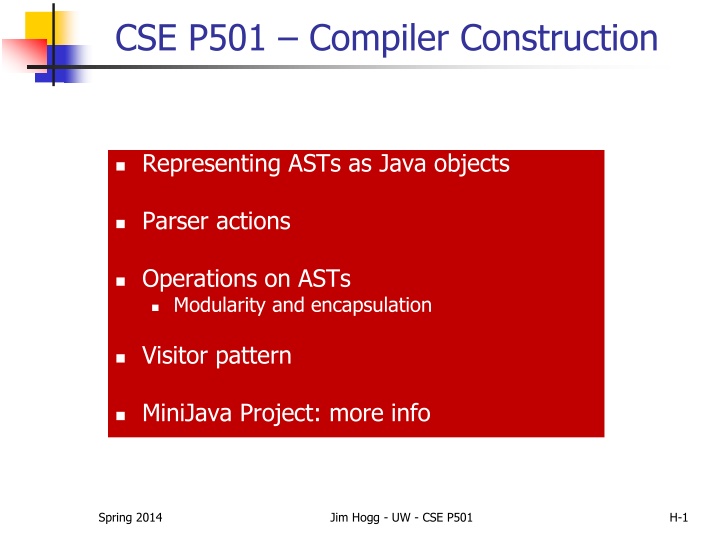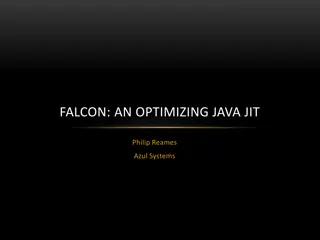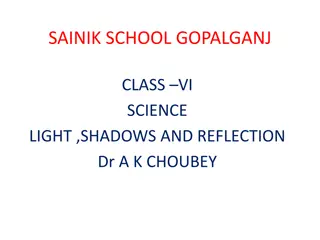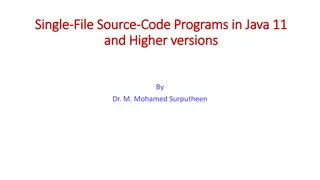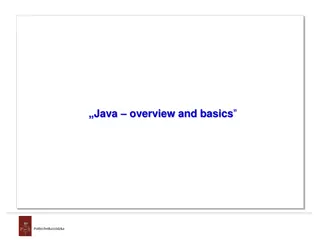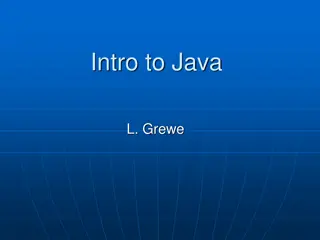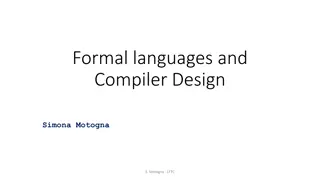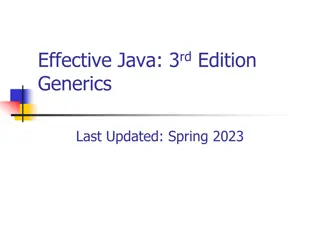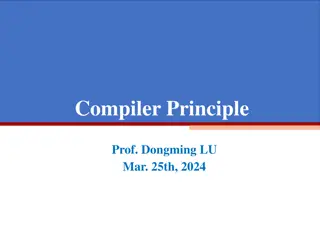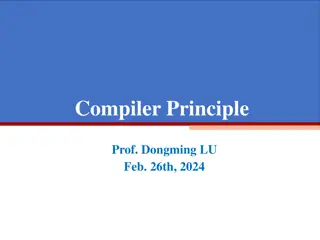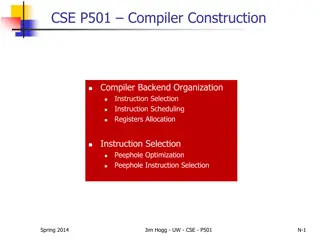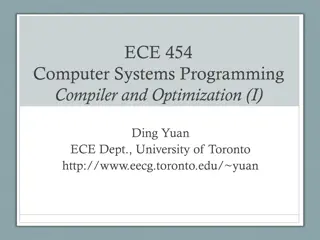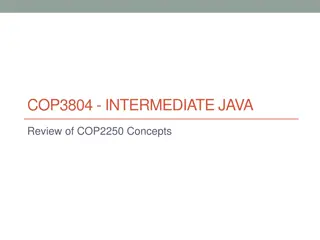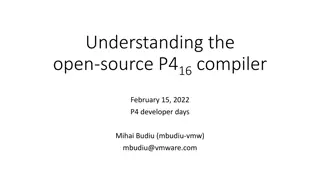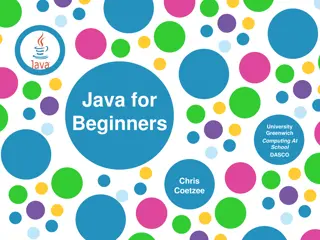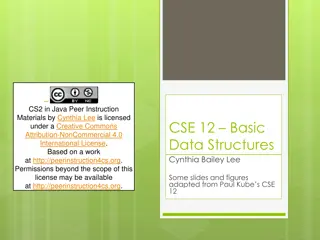ASTs as Java Objects in Compiler Construction
Discover the modular and encapsulated operations on Abstract Syntax Trees (ASTs) represented as Java objects in the context of compiler construction. Learn about the MiniJava project, AST target sources, middle-end and back-end operations, and the Visitor pattern. Gain insights into the core structure of programs captured by ASTs, emphasizing the use of small Java classes as records to represent AST nodes. Explore the AST node hierarchy in MiniJava, utilizing simple data structures to enhance understanding and implementation efficiency.
Uploaded on Apr 12, 2025 | 2 Views
Download Presentation

Please find below an Image/Link to download the presentation.
The content on the website is provided AS IS for your information and personal use only. It may not be sold, licensed, or shared on other websites without obtaining consent from the author.If you encounter any issues during the download, it is possible that the publisher has removed the file from their server.
You are allowed to download the files provided on this website for personal or commercial use, subject to the condition that they are used lawfully. All files are the property of their respective owners.
The content on the website is provided AS IS for your information and personal use only. It may not be sold, licensed, or shared on other websites without obtaining consent from the author.
E N D
Presentation Transcript
CSE P501 Compiler Construction Representing ASTs as Java objects Parser actions Operations on ASTs Modularity and encapsulation Visitor pattern MiniJava Project: more info Spring 2014 Jim Hogg - UW - CSE P501 H-1
AST Target Source Middle End Back End Front End chars IR IR Select Instructions Scan tokens IR Optimize Allocate Registers Parse IR AST Emit Semantics AST Convert IR Machine Code IR AST = Abstract Syntax Tree IR = Intermediate Representation Spring 2014 Jim Hogg - UW - CSE - P501 H-2
MiniJava Project Compiler chars Scan tokens Parse AST Semantics Assembler Text Assembler Machine Code No IR, Optimization or sophisticated instruction selection, or register allocation Spring 2014 Jim Hogg - UW - CSE P501 H-3
Recap: AST AST captures essential structure of a program, without the extra concrete grammar details needed to guide the parser So, no punctuation of grammar symbols used to define precedence & associativity (remember: E, T, F in Expression Grammar) Each node is a small Java object While > = while (n > 0) { n = n 1; } Id:n - Id:n Ilit:0 Id:n Ilit:1 Spring 2014 Jim Hogg - UW - CSE - P501 H-4
Representation in Java Basic idea: use small classes as records to represent AST nodes Simple data structures, not too smart pod = "plain old data" Take advantage of type system Use inheritance to treat related nodes polymorphically Following slides sketch the ideas; no need to use literally Spring 2014 Jim Hogg - UW - CSE - P501 H-5
AST Node Hierarchy in MiniJava Type BoolType And ArrLength ArrLookup Call False Exp Stm ArrAsg Asg Block Block IdType If IntArrType Less IntType IdExp Print IntLit While Minus ClassDecExt ClassDec NewArr NewObj ClassDecSim Not Plus FormalList ClassDecList ExpList Formal Id This Program MainClass MethDec MethDecList StmList Times VarDec True ??? Abstract Base Class Concrete Sub Class ??? Spring 2014 Jim Hogg - UW - CSE - P501 H-6
AST Nodes - Sketch // Base class of AST node hierarchy public abstract class Ast { // constructors (for convenience) // operations // string representation public abstract String toString(); // visitor methods, etc } Spring 2014 Jim Hogg - UW - CSE - P501 H-7
Some Statement Nodes // Base class for all statements public abstract class Stm extends Ast { } public class While extends Stm { public Exp exp; public Stm stm; public While(Exp exp, Stm stm) { this.exp = exp; this.stm = stm; } public String toString() { return "While(" + exp + ")" + this.stm; } } Note: most times we ll want to print the tree in a separate traversal, so no point defining a toString method Spring 2014 Jim Hogg - UW - CSE - P501 H-8
More Statement Nodes public class If extends Stm { public Exp exp; public Stm thenStm, elseStm; public If(Exp exp, Stm thenStm, Stm elseStm) { this.exp = exp; this.thenStm = thenStm; this.elseStm = elseStm; } public If(Exp exp, Stm thenStm) { this(exp, thenStm, null); } } Coding style: indentation & braces style chosen as compact for slides. Feel free to use any other, consistent style in your code Spring 2014 Jim Hogg - UW - CSE - P501 H-9
Expressions public abstract class Exp extends AST { } public class Plus extends Exp { public Exp e1, e2; // operands } public Plus(Exp e1, Exp e2) { this.e1 = e1; this.e2 = e2; } Spring 2014 Jim Hogg - UW - CSE - P501 H-10
More Expressions public class Call extends Exp { public Exp id; public List args; // method name // list of arg expressions } public Call(Exp id, List args) { this.id = id; this.args = args; } Spring 2014 Jim Hogg - UW - CSE - P501 H-11
Etc These examples are meant to illustrate the ideas; invent your own, if you prefer Eg, maybe better to have a specific AST node for argument list that encapsulates the List of arguments You ll also need nodes for class and method declarations, parameter lists, and so forth But strongly suggest using the AST classes in the starter code, taken from the MiniJava website Modify if you need to, and are confident you know what you re doing Spring 2014 Jim Hogg - UW - CSE - P501 H-12
Position Information in Nodes To produce useful error messages, record the source location ("source co-ordinates") in that node Most scanner/parser generators have a hook for this, usually storing source position information in tokens Included in the MiniJava starter code good idea to take advantage of it in your code Spring 2014 Jim Hogg - UW - CSE - P501 H-13
Parser Actions AST Generation: Idea: each time the parser recognizes a complete production, it creates an AST node That AST node links to the subtrees that are its components in the grammar production When we finish parsing, the result of the goal symbol is the complete AST for the program e1left = line number of e1 Note: aliases and line # in CUP: nonterminal Exp Exp; Exp ::= Exp:e1 PLUS Exp:e2 {: RESULT = new Plus(e1, e2, e1left); :} Spring 2014 Jim Hogg - UW - CSE - P501 H-14
AST Generation in YACC/CUP A result type can be specified for each item in the grammar specification Each parser rule can be annotated with a semantic action - a piece of Java code that returns a value of the result type The semantic action is executed when that rule is reduced Spring 2014 Jim Hogg - UW - CSE - P501 H-15
YACC/CUP Parser Specification NonTerminal Return type nonterminal Stm stm, while; nonterminal Exp exp; ... stm ::= ... | WHILE LPAREN exp:e RPAREN stm:s {: RESULT = new While(e,s); :} ; See the starter code for version with line numbers Spring 2014 Jim Hogg - UW - CSE - P501 H-16
Operations on ASTs Once we have the AST, we may want to: Print a readable dump of the tree ("pretty print") Useful to check & debug your code Do static semantic analysis: Type checking/inference Check variables are declared, and initialized, before use Etc, etc Perform optimizing transformations on tree Generate IR for further processing Generate code (eg: assembler text; machine binary) Spring 2014 Jim Hogg - UW - CSE - P501 H-17
Where do the Operations Go? Pure object-oriented style would advocate: Really, really smart AST nodes Each node knows how to perform every operation on itself: public class While extends Stm { public While(...); public typeCheck(...); public strengthReduce(...); public genCode(...); public prettyPrint(...); ... } Spring 2014 Jim Hogg - UW - CSE - P501 H-18
Critique This is nicely encapsulated all details about a While node are hidden in that class But it shows poor modularity: How to add a new optimization? Modify every node class Worse - details of any operation (eg: optimization, type- checking) are scattered across all node classes Spring 2014 Jim Hogg - UW - CSE - P501 H-19
Modularity Issues Smart nodes make sense if set of operations is relatively fixed, but we expect to to add new kinds of nodes Example: graphics system Operations: draw, move, iconify, highlight Objects: textbox, scrollbar, canvas, menu, dialog box, plus new objects defined as the system evolves Spring 2014 Jim Hogg - UW - CSE - P501 H-20
Modularity in a Compiler Abstract syntax does not change often over time ie, language syntax does not change often So, kinds of nodes are relatively fixed But, as a compiler evolves, it may be common to modify or add operations on the AST nodes Want to modularize each operation (type check, optimize, codegen) so its components are together, rather than spread across many class definitions (eg: 44 for MiniJava) Want to avoid having to change node classes when we modify or add an operation on the tree Especially true if compiler is "extensible" - supports plugins from 3rd parties that provide: usage, model conformance, compat warnings, API availability warnings, etc Spring 2014 Jim Hogg - UW - CSE - P501 H-21
Two Views of Modularity Compiler ASTs Graphics Package Class draw move iconify highlight transmogrify Class typeCheck optimize genX86Code Ffatten print ? Circle X X X X X Id X X X X X ? Text X X X X X Exp X X X X X ? Canvas X X X X X While X X X X X ? Scroll X X X X X If X X X X X ? Binop X X X X X ? Dialog X X X X X ? ? ? ? ? ? Spring 2014 Jim Hogg - UW - CSE - P501 H-22
Visitor Pattern Idea: package each operation (optimization, print, codegen, etc) into its own class Create one instance of this visitor class Sometimes called a function object Contains all of the methods for that particular operation, one for each kind of AST node Include a generic accept visitor method in every node class To perform the operation, pass the visitor object around the AST during a traversal Spring 2014 Jim Hogg - UW - CSE - P501 H-23
Avoiding instanceof Want to avoid huge if-elseif nests in the visitor to discover the node types void prettyPrint(Ast p) { if (p instanceof While) { ... } else if (p instanceof If) { ... } else if (p instanceof Plus) { ... } ... } Inelegant Inefficient - need to lookup object's type for each test OO provides a better way Spring 2014 Jim Hogg - UW - CSE - P501 H-24
Visitor Interface public interface Visitor { public void visit(While n); public void visit(If n); public void visit(Plus n); ... } Result type can be whatever is convenient; void is common parameter 'n' stands for "node" Spring 2014 Jim Hogg - UW - CSE - P501 H-25
Visitor Pattern: AST node In every AST node class, define 'accept' method. Eg: public class If extends Stm { public Exp cond; public Stm ifStm, elseStm; public If(Exp c, Stm s1, Stm s2) { cond = c; ifStmt = s1; elseStm = s2; } public void accept(Visitor v) { v.visit(this); } } Spring 2014 Jim Hogg - UW - CSE - P501 H-26
Visitor Pattern: PrettyPrinter In any class that walks the AST, such as PrettyPrint: public class PrettyPrinter implements Visitor { public void visit(If n) { this.print("If"); n.cond.accept(this); n.ifStm.accept(this); n.elseStm.accept(this); } public void visit(While n) { ... } ... } Spring 2014 Jim Hogg - UW - CSE - P501 H-27
Encapsulation A visitor object often needs to access state in the AST nodes So, may need to expose more node state (ie, "public" fields) than we would normally want Overall, however, a good tradeoff better modularity plus, the nodes are pods so not much to hide Spring 2014 Jim Hogg - UW - CSE - P501 H-28
References Visitor Pattern Design Patterns: Elements of Reusable Object-Oriented Software Gamma, Helm, Johnson, and Vlissides ("GOF") Addison-Wesley, 1995 Object-Oriented Design & Patterns Horstmann, A.W, 2e, 2006 MiniJava AST and visitors: Modern Compiler Implementation in Java; Appel; 2e; 2013 Website: http://www.cambridge.org/us/features/052182060X/#grammar Spring 2014 Jim Hogg - UW - CSE - P501 H-29
Next Static Analysis Type-checking How to represent Types Context-Sensitive Rules declare-before-use; type-matching; etc Symbol Tables Spring 2014 Jim Hogg - UW - CSE - P501 H-30
